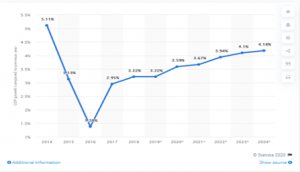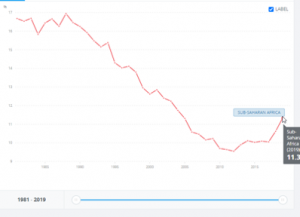Share
The recent outbreak of the global Coronavirus pandemic has triggered worldwide panic as the number of confirmed victims continues to rise across the world. Due to the severe economic and social impact posed by COVID-19, the disease associated with the virus, the World Bank projected that economic growth in Sub-Saharan Africa will decline from 2.4 per cent in 2019 to between -2.1 to -5.1 per cent in 2020. The continued high risk of contagion notwithstanding, deteriorating economic conditions have intensified the urgency to reopen economies particularly in developing countries and adopt recovery policies that can be turned into long-term industrialization opportunities.
Africa’s journey of industrialization has been a tumultuous one. The Lagos Plan of Action (1980-2000) developed by the Organization of African Unity envisioned a self-reliant and self-sustaining Africa. From the concepts of the Lagos Plan of Action emerged the idea of a decade specifically devoted to industrial programmes and projects thus giving birth to the First Industrial Development Decade for Africa (IDDA I). The IDDA I programme (1980-1990) was launched at a time when many African countries had initiated policies in response to the crises of the 1980s attributed to heavy external debt and the servicing burden, collapse of world commodity prices and the application of inappropriate policy measures that created instability in the main macro-economic variables. Industrialization in Africa therefore did not become a reality. During the Second IDDA (1993-2002), intentions for Africa’s industrialization were not translated into concrete and practical programmes and projects and it did not involve the donor community and other UN agencies in its design hence, there was no commitment on their part for implementation.
The need for Africa to industrialize was reflected in a resolution by the United Nations General Assembly (UNGA) through the proclamation of the Third Decade. In July 2016, the UNGA adopted resolution A/RES/70/293 proclaiming the period 2016-2025 as the Third Industrial Development Decade for Africa (IDDA III). The vision of IDDA III was to firmly anchor Africa on a path towards inclusive and sustainable industrial development (ISID). Industrialization is key if countries are to achieve the Sustainable Development Goals by 2030, in particular SDG 1, which calls for no poverty, and SDG 9 which aims to build resilient infrastructure, promote inclusive and sustainable industrial development and foster innovation.
Status of Industrialization in Sub-Saharan Africa
Despite the prevalent economic difficulties in Sub-Saharan Africa, the state of the continent was good before COVID-19. Growth rate of real gross domestic product (GDP) was projected to accelerate to 3.59% in 2020 compared to 3.22% in 2019. It however, remains insufficient to address the structural challenges of fiscal deficits and debt vulnerability. The challenge lies in increasing the efficiency of growth in generating employment for the growing population of Africans especially the youth and raising the current growth rate hence contributing to the goal of poverty eradication. This can be accelerated when industry leads growth, suggesting that industrialization is a robust path to rapid job creation.
Figure 1: Gross domestic product (GDP) growth rate in Sub-Saharan Africa

Source: Statista
Industrialization has been acknowledged to bring prosperity, employment and higher incomes for people. Yet the continent is less industrialized today than it was in the 1980s. Manufacturing value added (% of GDP) in Sub-Saharan Africa has declined from 16% in 1981 to 11.3% in 2019 as seen in the graph below.
Figure 2: Manufacturing value added (% of GDP)- Sub-Saharan Africa

Source: World Bank
Between 1965 and 1990, real per capita GDP rose twice as fast in East Asia than in any other regional grouping. In what came to be known as the East Asian Miracle, one of the key drivers to development was Government’s activist policies to quicken the pace of industrialization and export an increasing proportion of industrial output. In Sub-Saharan Africa where poverty is almost the rule, not the exception, industrialization therefore has a major part to play as the engine for economic growth and prosperity.
IDDA III represents one of the most important undertakings of the decade endorsed by the global community in favour of industrialization. It is also in line with various programmatic frameworks where the need for sustainable industrialization of Africa is underlined, for instance, the African Union’s Agenda 2063 and its First Ten Year Implementation Plan, the African Continental Free Trade Area (AfCFTA) and the African Union’s Action Plan for the Accelerated Industrial Development of Africa (AIDA) among others.
Rapid population growth and the occurrence of a demographic transition in Africa have generated discussions on the need to strengthen the ability of economies to absorb the growing labour force. By 2050, Africa is projected to double its population to about 2.4 billion people whereby the youth will be the majority. This presents a window of opportunity for IDDA III to harness the growing labour force and ensure that Africa is on a path to sustained economic development through ISID. IDDA III is therefore expected to be a game changer; it can transform the structure of Africa’s economies and jumpstart them towards rapid development through industrialization.
Conclusion
Industry has always played a vital role in development. It boosts economic activity along value chains from raw materials to finished products and generates formal employment, which in turn creates social stability and reduces the poverty levels. Some countries in Africa, for instance, Rwanda and Ethiopia have proved adept at navigating the bumpy path to industrialization. The common factor is that they have embraced policies that target and favour their own manufacturing industries thus showing that industrialization can happen in other countries in Africa
In the midst of the COVID-19 pandemic, the time is ripe for Africa to industrialize. Africa must not miss opportunities for creating linkages whenever and wherever they occur through adding value to its raw materials and primary products. Despite the current health and economic challenges posed by the COVID-19 crisis, Africa has an opportunity to leverage IDDA III to foster industrialization by strategically building synergies between policy areas such as healthcare and industry. As the resolution proclaiming the IDDA III states, the African continent needs “to take urgent action to advance sustainable industrialization as a key element of furthering economic diversification and value addition, creating jobs and hence reducing poverty and contributing to the implementation of the 2030 Agenda”.
The views expressed in this article are those of the author alone and not the Future Africa Forum.
The views expressed in this article are those of the author and do not necessarily reflect the views of Future Africa Forum. Future Africa Forum is a pan-African policy think-tank and policy advisory consultancy headquartered in Nairobi, Kenya.



